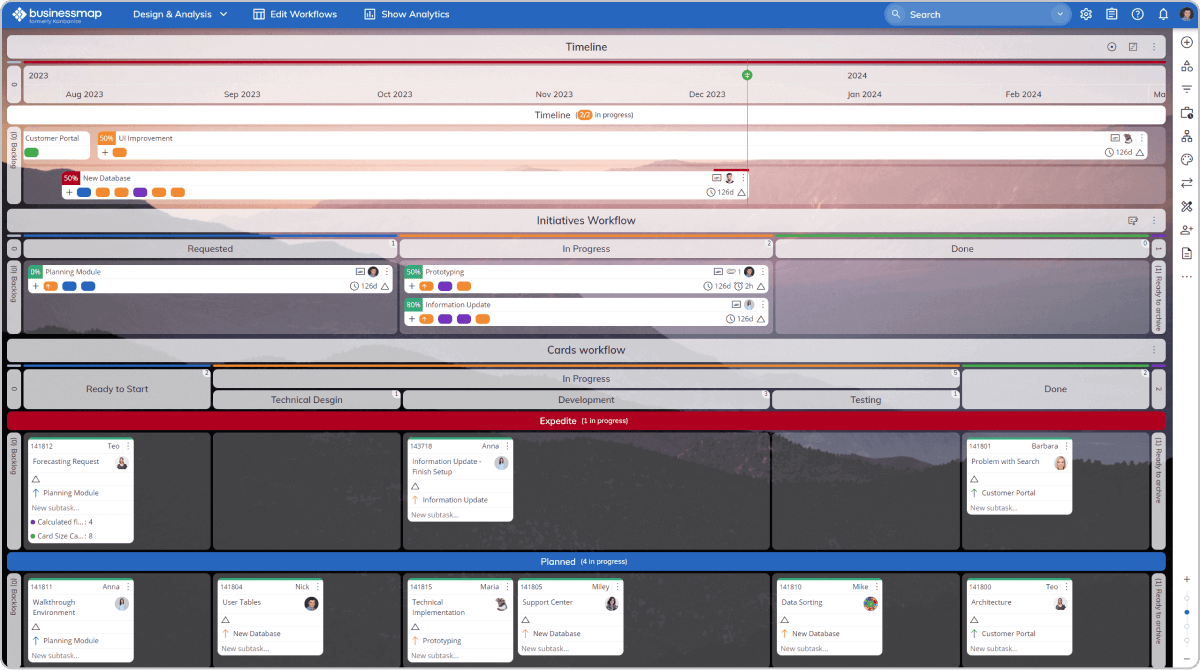Key Takeaways
-
What is the goal of visual project management tools? Visual project management software makes project progress and bottlenecks instantly visible through boards, timelines, and dashboards.
-
How to choose? Choosing the right platform requires evaluating core features, pricing, and integration capabilities.
-
Best tool: Businessmap leads for enterprise-ready visual project management with unmatched scalability and strategy alignment tools.
Today, project visibility is no longer optional - it's the foundation for timely decisions and successful delivery. Spreadsheets, long email threads, and static reports can't keep up with the speed of modern work.
Visual project management software solves this by giving teams a shared, real-time view of projects, resources, and dependencies. These platforms replace guesswork with interactive boards, timelines, and dashboards - making it possible to see problems before they cause delays and to keep strategy and execution tightly connected.
In this guide, we review the top 8 visual project management software tools for 2025, compare their standout features, and answer three essential questions every decision-maker should consider:
-
How can you prove the ROI of investing in visual project management software?
-
Which features are must-haves versus nice-to-haves?
- What pricing models and hidden costs should you anticipate?
1. Businessmap
Businessmap is purpose-built for organizations that want to scale visual project management across teams and portfolios while aligning every task to strategic goals.
Notable visual project management features:
- Interactive Kanban boards with live updates
- Multiple workflows on a single Kanban board for complex processes
- Timeline views for planning and status reporting
- Gantt charts for detailed scheduling and dependencies
- Hierarchical management boards linking strategy to execution
- OKRs and KPIs status tracking
- Portfolio-level visibility across departments
- Customizable reporting and analytics dashboards
Notes: What sets Businessmap apart is its ability to connect the entire hierarchy of work - from high-level portfolio objectives to granular task execution - within a single system. This makes it possible for leadership to see how strategy is unfolding in real time. Features like multiple workflows per board are especially valuable for cross-functional organizations with varied processes. Case studies like Aerosud's adoption show how the platform can manage complex engineering projects while maintaining strict deadlines and compliance.
 Visualizing work hierarchy with timeline, initiative/project views, and work breakdown into individual items using a work board in Businessmap
Visualizing work hierarchy with timeline, initiative/project views, and work breakdown into individual items using a work board in Businessmap
2. Wrike
Wrike delivers a highly customizable environment where teams can design visual workflows that reflect their unique processes.
Visual project management features:
- Kanban boards for task visualization
- Gantt charts with drag-and-drop scheduling
- Workload view for resource management
- Custom dashboards and reports
- Integrations with Salesforce, Slack, MS Teams, and more
Notes: Wrike's flexibility is a major advantage, but it often requires careful setup and onboarding to unlock its full potential. Pricing can climb quickly when you need advanced automation, detailed reporting, or enterprise-grade features. Teams looking for deep customization will appreciate its adaptability, but they should plan for a learning curve.
3. Miro
Miro started as a collaborative whiteboard platform and has since evolved to support project visualization.
Visual project management features:
- Infinite whiteboard for brainstorming and mapping workflows
- Templates for Kanban, timelines, and mind maps
- Sticky notes, shapes, and connectors for visual planning
- Integrations with Jira, Asana, Trello, and more
Notes: Miro excels in the early stages of work - brainstorming, ideation, and initial planning. However, it lacks the robust task management, dependency tracking, and reporting capabilities that dedicated project management software provides. Many teams use Miro in conjunction with a more structured platform to handle execution.
4. Asana
Asana blends intuitive task management with multiple visualization options, making it easy for teams to transition from manual methods.
Visual project management features:
- Kanban boards for workflow tracking
- Timeline view for scheduling
- Workload view to manage capacity
- Goal tracking to align projects with strategy
- Rules-based automation to save time
Notes: Asana's clean design and straightforward setup make it appealing for small to mid-sized teams. However, scaling to larger organizations can become expensive, especially if you need advanced analytics or integrations. Its strength lies in keeping tasks organized and visible without overwhelming users.
5. Monday.com
Monday.com offers a colorful, highly visual interface with broad customization options for managing projects and workflows.
Visual project management features:
- Boards with multiple view options (Kanban, timeline, calendar)
- Gantt charts for project planning
- Workload view for resource allocation
- Automation for repetitive updates and status changes
- Industry-specific templates
Notes: Monday.com's adaptability attracts teams from various industries, from marketing to operations. However, the sheer variety of options can be daunting for new users. Finding the optimal configuration may require trial and error. Additionally, certain valuable features - like time tracking and advanced permissions - are reserved for higher-tier plans.
6. ClickUp
ClickUp positions itself as a comprehensive productivity hub, combining project management with documentation, goals, and communications.
Visual project management features:
- Kanban boards, Gantt charts, and timeline views
- KPI dashboards
- Goal setting and progress tracking
- Custom fields and workflows
- Mind maps and workload view
Notes: ClickUp's biggest advantage is its breadth of functionality, which allows teams to consolidate multiple tools into one platform. However, that breadth can feel overwhelming if you only need focused visual project management. Regular feature updates keep it competitive, but sometimes require teams to adapt workflows on the fly.
7. Teamhood
Teamhood caters to agile-friendly visual project management for small and medium-sized teams.
- Visual project management features:
- Kanban boards with advanced swimlanes
- Gantt charts for planning
- Dependency tracking to manage workflow risks
- Workload view for capacity balance
- Built-in time tracking
Notes: Teamhood offers a strong balance between agile flexibility and structured planning. While it doesn't have the same portfolio-level oversight as enterprise-focused platforms, its ease of setup and straightforward interface make it an appealing choice for agile teams wanting clarity and speed.
8. Teamwork.com
Teamwork.com is tailored to client-facing project management, blending internal collaboration with client transparency.
Visual project management features:
- Task boards with custom stages
- Gantt charts and timelines
- Client portals for shared updates
- Time tracking and billing tools
- Project templates for repeatable processes
Notes: Service-based teams and agencies will appreciate Teamwork.com's client portal, which allows external stakeholders to view progress without exposing internal systems. While it offers a strong set of features, some advanced automation and reporting tools require higher-tier subscriptions.
How to Justify the ROI of Visual Project Management Software
The most persuasive ROI cases combine measurable metrics with qualitative benefits. Start by establishing a baseline before implementation:
- Lead time from request to delivery
- Cycle time for active tasks
- Throughput or completed tasks per period
- On-time delivery rates
Then, post-implementation, compare results. Even modest gains - like a 15% reduction in lead time - can represent significant productivity savings.
Beyond numbers, emphasize improvements in team morale, reduced reliance on meetings, and faster cross-departmental coordination. These often translate indirectly into higher customer satisfaction and increased capacity for new projects.
Essential vs. Nice-to-Have Features
When evaluating software, focus first on core capabilities that directly support your workflows:
Essential:
- Kanban boards
- Timeline and Gantt views
- Multiple workflows per board
- Portfolio-level visibility
- Key integrations (Slack, Jira, MS Teams, CRM)
Nice-to-Have:
- Built-in OKR/KPI tracking
- Whiteboarding tools
- Time tracking
- Industry-specific templates
Avoid being swayed by flashy features you won't use - each unused capability adds cost and complexity without adding value. That said, consider your growth trajectory; the right tool should scale with you.
Comparing Pricing Models & Hidden Costs
Most visual project management software follows one of these models:
-
Per user, per month: Straightforward but can scale costs quickly.
-
Tiered by feature set: Lower tiers often lack advanced reporting or automation.
-
Flat fee for unlimited users: Less common but cost-effective for stable team sizes.
Potential hidden costs include:
- Onboarding and training time
- Integration and API setup fees
- Costs for customizations and workflows
- Storage upgrades for large file handling
»» Pro tip: Test the specific tier you'll purchase - not just a free plan - to uncover any functional limits before making a commitment.
Conclusion
Visual project management software replaces uncertainty with clarity, giving teams a real-time view of progress, priorities, and risks. While all eight tools reviewed here offer value, Businessmap stands out for organizations that need to connect strategy with execution, manage multiple workflows, and gain portfolio-level insights in one platform.
For leaders aiming to improve alignment, accelerate delivery, and make data-driven decisions, Businessmap offers a complete, scalable solution that grows with your organization.
Businessmap is the most flexible software
to align work with company goals





 Visualizing work hierarchy with timeline, initiative/project views, and work breakdown into individual items using a work board in Businessmap
Visualizing work hierarchy with timeline, initiative/project views, and work breakdown into individual items using a work board in Businessmap

